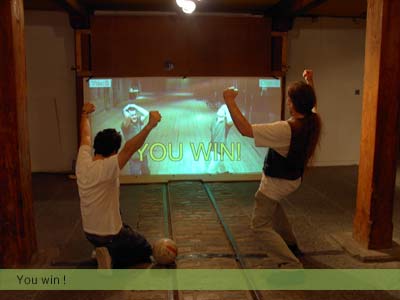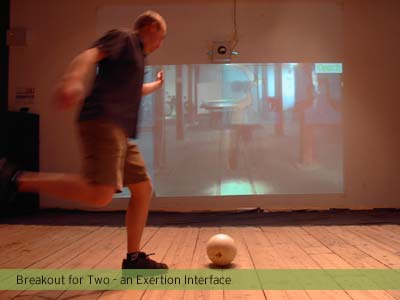Results

Questionnaire
The questionnaire revealed many statistically significant findings between
the exertion and non-exertion group. The main conclusions regarding social
interaction were that the exertion group indicated:
• they got to know the other player better
• they believed that the game created a stronger social bond between
them
• the other player seemed to become a better friend
• the other player could trust them more
• they were happier with the quality of the video-conference
• they perceived the other player more talkative in comparison to the
non-exertion group.
The players who played the exertion game also stated that they
• had more fun with the game
• liked the game more
• played longer
• and felt more positive about the overall experience.
Prisoner's Dilemma
The Prisoner’s Dilemma task did not turn out to be a valid measurement for interpersonal trust between the participants. Although the questionnaire data revealed participants in the exertion condition were more certain that their game partner could trust them, the Prisoner’s Dilemma showed the opposite. Three reasons might explain this. Firstly, the participants had to change from a competitive game to a collaborative task. Secondly, they regarded it as a completely separate issue, which they did not associate with the physical game. Some participants confirmed this during the interviews. Thirdly, the participants were “hyped up” by the physical competition, eager to compete, and played a poker-like game with each other, where they were trying to predict the other person’s future actions in order to win more money.
After the interview, some players from the exertion-group commented that
they “knew” the other player would put down an X, and that they
did not want the other player to get “all the money”, so they
put an X down themselves. It was not a matter of how to gain more money, but
how to make the other player not get more than oneself.
In particular, players in the exertion group made comments such as “the
other player was so nice, I knew she would not put an X down”, putting
down an X themselves, just because they were so sure about it. This is an
indicator that this group was able to assess the other person and was more
confident in predicting her/his future actions.
Interviews
In addition to the questions asked through the questionnaire, the participants were interviewed after the game together to give them a more open format to express their opinion and thoughts.
The interviews with the people who played the exertion game lasted much longer than the interviews with the non-exertion players. They seem to be more comfortable chatting freely and interacted longer, showing a deeper involvement.
There were quite a few people who said that they do not like computer games, because “they are just not my cup of tea”, but that if these games had an exertion component, as demonstrated with the Exertion Interface, it would be a different experience: “For a game like that, that has a competitive edge, I’d say a ball there and you actually running around doing something, you’d feel like more competing than just pressing a button because it seems very remote and clicking, but if you are running about and doing something it will immediate spark much better than, for me anyway because I am used to playing sports.”
Another player commented that the exertion game also gave a good opportunity to level out players in terms of their skills. If one person cannot kick the ball, she or he can just throw it. This way sports enthusiasts who would normally be too different in their abilities could play together.
Most players, especially in the exertion group, said that the limited video
quality did not bother them; one participant actually said that she liked
it this way. Not being able to see the other person perfectly prevents one
from getting too exposed and can hide embarrassing moments that might occur
during the game. She liked this because she was able to “hide”
behind the compression artifacts. Another player commented about the fact
that the smell of sweat luckily does not get transmitted.
One participant mentioned that he would like to see such a game in a bar,
allowing him to play with friends who could not be there.
Almost all of the players in the exertion group were very exhausted after the game. Most of them said that it was much more exhausting than they thought it would be in the beginning. Indeed, the game can be very demanding and fatiguing. The reason for this is because there are no opponents or teammates to wait for and there are no scheduled time-outs. Only when both players agree on a break, they can have one.
The interviews strengthened the findings from the questionnaire. It was valuable to see confirming statements in a more open format than that allowed by the questionnaire. The players confirmed the proposal that the exertion game helped them to get to know each other better.
Conclusion
 Whether
people prefer computer games or physical games depends on the situation and
the personality of the player. Not everybody will like participating in a
physical game, regardless of whether that game is played over a distance or
on the same court. An Exertion Interface, however, gives these different characters
the option to play with somebody remotely. One participant stated: “Computer
games are not for everybody, they are certainly not my cup of tea, I prefer
sports”.
Whether
people prefer computer games or physical games depends on the situation and
the personality of the player. Not everybody will like participating in a
physical game, regardless of whether that game is played over a distance or
on the same court. An Exertion Interface, however, gives these different characters
the option to play with somebody remotely. One participant stated: “Computer
games are not for everybody, they are certainly not my cup of tea, I prefer
sports”.
Experiments with the system demonstrated that participants who played Sports over a Distance reported a significantly greater social bond than players who used a keyboard interface. The users of the Exertion Interface also said that they had more fun and rated the overall experience higher.
The addition of an Exertion Interface to currently available interface designs opens the door to another world of social interfaces. This interface is not designed for a wide range of applications, where traditional keyboard interfaces are much more suitable (e.g. word-processing and programming), but in supporting social interactions, an Exertion Interface is advantageous. This approach moves in the opposite direction to most other current interface design trends, because although it is easy to learn, an Exertion Interface requires skill and strength, and is hard to master.
An Exertion Interface supports people connecting with one another, whether they are friends or have never met before. Players use the universal language of sports to come together, and they now can do this with people situated on the other side of the world.